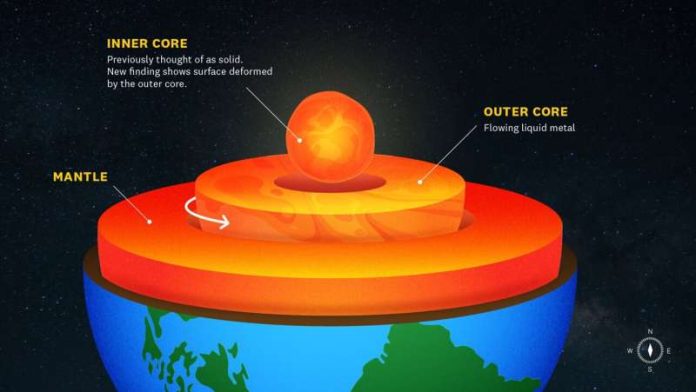
Scientists have found new evidence that the Earth’s inner core may be changing over time. A recent study by researchers at the University of Southern California (USC), published in Nature Geoscience, suggests that the surface of the inner core is not as stable as previously thought.
Instead, it appears to be undergoing structural changes, possibly due to interactions with the surrounding molten outer core.
For many years, scientists have debated whether the Earth’s inner core changes or moves. Most studies have focused on how the inner core rotates, but this new research suggests something different—it shows that the inner core’s surface itself may be shifting.
This discovery could help explain small changes in the length of a day on Earth and provide new insights into how the core affects our planet’s rotation.
A Deep Look into the Inner Core
The Earth’s inner core is a hot, dense sphere made mostly of iron and nickel. It lies about 3,000 miles (4,800 kilometers) below the surface and is surrounded by the liquid outer core. Scientists have long believed that the inner core is solid, while the outer core is molten.
Because it is buried so deep inside the Earth, researchers cannot directly observe it. Instead, they study it by analyzing seismic waves—vibrations that travel through the Earth after earthquakes.
USC scientists set out to study the slowing of the inner core’s rotation. But while analyzing decades of seismic data, lead researcher John Vidale noticed something unusual. One set of earthquake signals looked different from the others.
“At first, I didn’t understand what I was seeing,” Vidale said. “Later, I realized it was evidence that the inner core might not be completely solid.”
To investigate further, the team examined earthquake data recorded from 1991 to 2024. They focused on 121 earthquakes that occurred near the South Sandwich Islands, a remote region in the South Atlantic Ocean.
These earthquake waves traveled through the Earth and were detected by sensors in Alaska and Canada. While most of the seismic data looked normal, one set from a Canadian station showed unexpected changes in the signals.
The Inner Core May Not Be Solid and Unchanging
After improving their analysis, the researchers found that the changes in the seismic waves likely came from shifts in the inner core’s surface. The study suggests that the inner core may be deforming over time, meaning its shape is slowly changing due to forces acting on it.
One possible explanation is that the molten outer core is affecting the inner core more than scientists previously thought. The outer core is known to be in constant motion, creating the Earth’s magnetic field.
However, until now, scientists had not observed the outer core causing noticeable changes in the inner core on human timescales. Vidale believes that the turbulence in the outer core may be pushing against the inner core, causing it to shift slightly.
What This Discovery Means
This finding challenges the long-standing idea that the inner core is a perfectly solid sphere. Instead, it appears to be more dynamic, with changes happening over time. Understanding these shifts could help scientists learn more about the Earth’s deep interior, including how the core affects the planet’s magnetic field and rotation.
The study also raises new questions. If the inner core is changing shape, how does this impact the rest of the Earth? Could these changes influence earthquakes or the planet’s climate in the long term? Scientists will need more research to find answers, but this discovery is a major step in understanding the mysterious depths of our planet.
Analysis of the Findings
This study provides a fresh perspective on Earth’s inner core. Previous research mostly focused on the inner core’s rotation, but this new evidence suggests that its surface is also changing. The fact that these changes were detected using seismic waves from earthquakes makes the discovery even more remarkable.
One of the biggest implications of this finding is that the Earth’s deep interior is more active than scientists thought. The idea that the outer core’s turbulence can influence the inner core in a measurable way could lead to new theories about how Earth’s internal layers interact.
This could also improve our understanding of the planet’s thermal and magnetic processes, which play a key role in protecting Earth from harmful solar radiation.
However, there are still many unanswered questions. Scientists do not yet know how fast or how much the inner core is changing. It is also unclear whether these changes have any significant effects on life at the surface. More studies will be needed to confirm these findings and explore their potential consequences.
For now, this discovery reminds us that even the deepest parts of our planet are not as stable as we once believed. Earth’s inner core is still a mystery, but step by step, scientists are uncovering its secrets.
The research findings can be found in Nature Geoscience.
Copyright © 2025 Knowridge Science Report. All rights reserved.



